RECOIL OFFGRID Preparation Layering Your EDC Survival Gear
There’s discussion ad nauseum in preparedness circles about redundancy and layering of gear and survival gear. Like many survival concepts, grand-scale guidance is distilled down to a catchphrase that’s then so beat-to-death that people lose track of what it actually means. One of our favorites is “two is one, one is none.” It makes sense on the surface, but gets tossed around so much in forums and discussions that it becomes its own form of radio static. So, we thought we’d go down to brass tacks and talk about exactly why layering is important and how to do it. As always, what we present here is one way — not the only way. And, as a concept, layering is scalable to your own readiness needs. We’ll provide some specific examples as a handrail for you. But the specific layers you create should be tailored to your daily routine and the contingencies you feel are most important to prep for.
One of the best layering strategies we’ve come across is known as the “Line Gear” concept. We can’t verify for certain who coined the term or how exactly it started. We got it from an Army Special Forces veteran, and the anecdotal stories we’ve heard go something like this …
During the Vietnam War, U.S. Special Operations Forces adopted a methodology of using small, highly trained reconnaissance patrols to search the jungle for enemy forces and activity. These tiny teams, sometimes only four or six men strong, were able to move quietly and collect information about enemy movements. Many times, these teams would wind up in direct combat with forces vastly larger in size and firepower. In such cases, escape and evasion was the only effective way to survive the encounter. The ability to break away from a pursuing enemy and melt into the jungle became vital. In some cases, this meant shedding heavy rucksacks or jangling equipment vests to move faster and make less noise. But in the heat of the fight, it can be difficult to decide exactly what equipment to jettison and what to keep with you no matter what. So, the idea of organizing your gear into “lines,” based on importance and where you store it in your load-out, became a simple and effective way to avoid rationing or decision-making on the fly while under fire. With some interpretation on our part, the basic concept broke down as follows:

First Line Gear was essential survival gear. This stuff was kept on your body — perhaps on your trouser belt or stuffed in your pockets — and was considered the bare minimum for successful escape, evasion, and survival. Nuts-and-bolts necessities like a compass, map, waterproof matches, emergency signaling devices, and some basic first-aid items were in this category.
Second Line Gear was what survival gear you needed to do your immediate job. In the case of a small jungle recon team, this was what they needed to shoot, move, and communicate — things like primary weapons, ammunition, grenades, and radios. These items normally go on a soldier’s load bearing vest, chest rig, or plate carrier.
Third Line Gear was survival gear that provided long-term sustainment and comfort. Spare batteries, extra socks, rations, shelter half, Claymore mines, and anything needed for a 72-hour patrol were kept in a pack or rucksack for retrieval as needed.
The above lists are by no means comprehensive — they’re generic examples of how to organize and classify your overall load by necessity. In the jungle war context, packing your equipment in this philosophy bears out that, if falling back under fire, the long-term-use gear in your rucksack could be dropped on the run to gain speed and reduce noise while still leaving you with the necessary equipment to fight the enemy and provide for basic survival needs. If, for some reason, you became separated from your weapon and fighting equipment, the items in your pockets and on your belt could still allow you to live long enough to return to friendly lines or be picked up under in-extremis circumstances.
Thankfully, very few of us will ever have to worry about sacrificing large amounts of equipment to evade an enemy force in direct pursuit. But this concept can still be adapted to help us better organize our EDC and bug-out bags in a succinct, prioritized manner. Odds are most of us do this already, to some extent. The idea of walking in and out of work every day with a rolling duffel bag of survival equipment is unrealistic. The things we deem essential to have at all times become our EDC, and everything else gets stashed or staged elsewhere for use as the situation dictates. What we like most about this method is that it forces us to sit down and truly assess what’s important to have on us, right now, for immediate use, versus what can be packed, stowed, or stashed for retrieval if and when needed.
The approach is highly scalable and can be made your own, depending on what your routine requires. For soldiers deployed overseas, their rifle and body armor with attached ammunition pouches would be Second Line survival gear, as it’s required to do their primary job. But for a prepared citizen, these same items would likely be relegated to Third Line survival gear since, especially in an urban setting, they’re less likely to be used and more likely to be left behind if the immediate situation doesn’t include contested gunfights at distance. (Contrast this with a defensive handgun that, for many, might be considered First Line Survival Gear to be carried daily.) What follows are some examples we’ve put together to best illustrate the ideas, and to give you some inspiration to “line up” your own gear.
First Line: On-Body Carry (EDC)
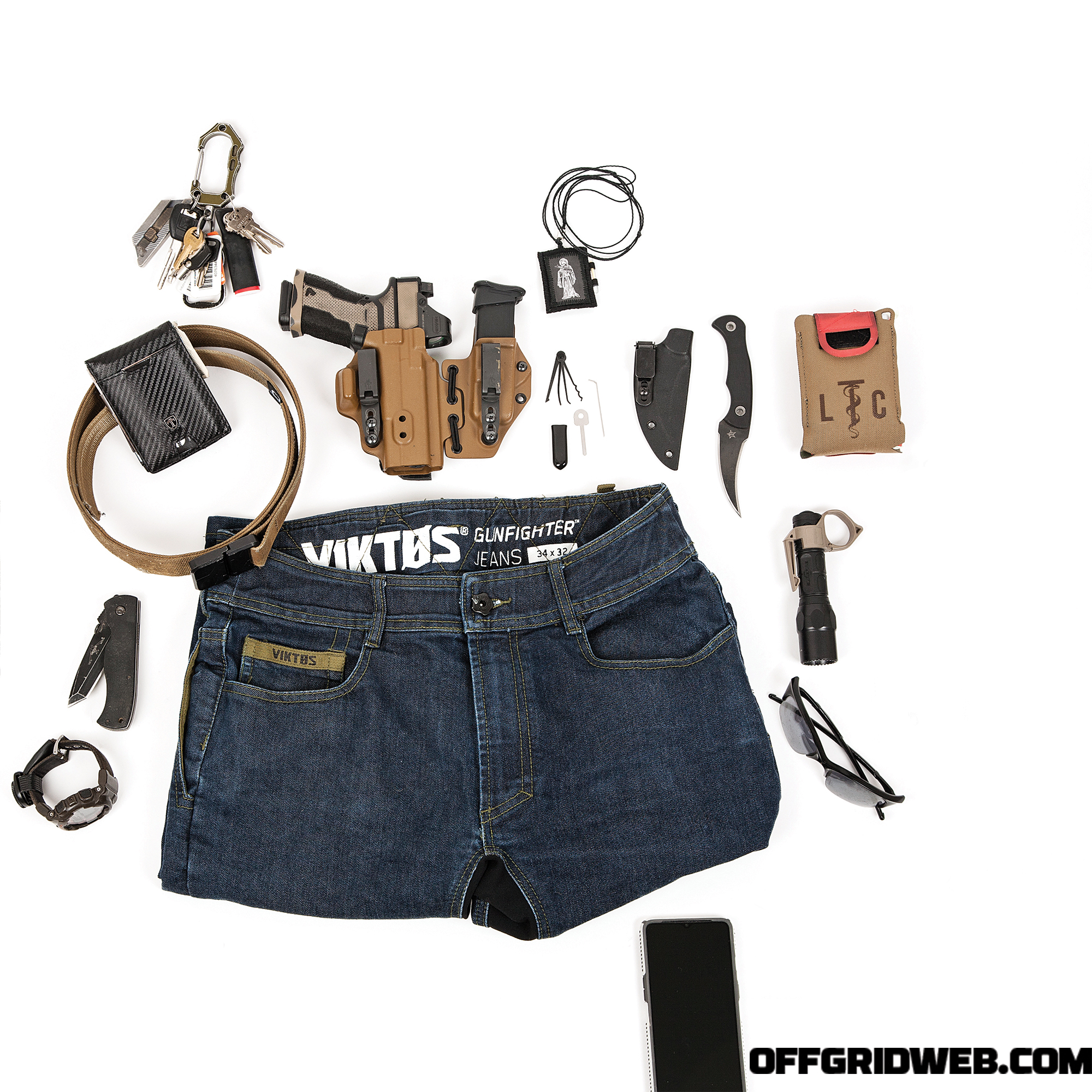
When all laid out for this photo, we realized just how much gear it's possible to carry comfortably and concealed in a well-broken-in pair of jeans and a loose T-shirt.
Carbon Tactics Badger Strap Belt
The Badger Strap’s double thickness makes it ideal for supporting holsters and holding up pants laden with the rest of the carry loadout.
SureFire G2X LE Flashlight with Thyrm “Switchback” Ring
The SureFire G2X series is lightweight and inexpensive, while still bringing 500 lumens to bear with a click of the tailcap. Adding the Thyrm Switchback ring provides both a pocket clip and a highly intuitive way to use the light while maintaining a two-hand grip on a pistol, if need be. The “LE” variant offers two outputs: 60 lumens and 500 lumens, but always offers 500 on the first button push. If you want to step down to 60 lumens for admin tasks, double tap the clicky tailcap. No programming, no extra switching, no twist-for-this, push-for-that.
Zero Tolerance 0566
The Zero Tolerance name is synonymous with hard use and high performance. Their now-discontinued 0566 line provides a slimmer, more discreet EDC option over some of their other offerings. (Pictured above is my previous EDC knife, a well-worn Emerson CQC-7BT.)
Casio G-Shock Watch
The G-Shock watch is bombproof and easy to operate, no stranger to hard-use environments like war zone deployments. (This particular watch has been to Afghanistan a dozen times.) In addition to the quick-reference navigation aid of the Suunto Clipper compass, the Gearward A-K (Anti-Kidnapping) band allows you to carry some sneaky escape tools like a nonmetallic handcuff key and ceramic razor blade.
LAS Concealment Ronin 3.0
A lot of holsters come across our desks. But the Ronin 3.0 from LAS Concealment has quickly become one of our favorites. It includes both holster and spare mag carrier, joined together by a length of elastic cord. This gives the rig a degree of flexibility that allows it to move with your body without the shifting, tilting, and sliding we experience when running an IWB mag pouch that’s entirely separate from the holster.
JB Knife Ditch Pik
A concealed, dedicated defensive fixed blade is typically faster and easier to bring to bear in a fight, versus having to pocket-draw and open a similar-sized folder. There are some excellent boutique knife makers specializing in sharp things for street fights. One of our favorites is the Ditch Pik from JB Knife & Tool in collaboration with our friend and colleague Ed Calderon. It’s available in a number of different configurations. This one has G10 scales and a full-length double-edged blade. We tested this knife thoroughly in Ed’s own Organic Medium Entry class — see “Sharp Edges and Dirty Tricks” in Issue 36 for more on that class — and found that it performed excellently, including stabbing through a standard-issue soft body armor vest without so much as slowing down. Depending on the circumstances, we carry our Ditch Pik instead of, or in conjunction with, our Glock 19.
LTC Pocket IFAK
The Live the Creed pocket IFAK is a drop-it-in-your-pocket way to carry some basic trauma supplies like gloves, anti-clotting agent, and chest seals.
“Scapular” E&E Necklace
This unassuming piece of jewelry came to us by way of a somewhat cryptic Instagram user known as @whoiscitizene. We got in touch with “E” through RECOIL OFFGRID alum William Echo. The necklaces are based heavily on the teachings of Ed Calderon. The Scapular consists of a Kevlar cord held together by small magnets, instead of a clasp. On the end of the Kevlar line is a small square pocket made of felt, adorned with Calderon’s signature “Sneak Reaper” totem. The felt pocket is small, so whatever you keep in it must be micro-sized. Luckily, there are a number of companies producing specialty SERE tools with incredibly reduced footprints. We chose a handcuff shim and an ITS Tactical OSS Tool. The latter is a set that consists of a pint-sized tension wrench and several styles of lockpicking rakes on a small swivel bearing, allowing them to be fanned out like a poker hand without having to detach the individual tools to use them. The Scapular also has teeny-tiny elastic loops, which hold the smallest chemlight we’ve ever seen. Locked in a dark trunk or the back of a windowless panel van? Crack the chemlight, and you’ll have just enough light to see, access, and use your tools.
Tuff Writer Carabiner
We’ve featured several Tuff Writer products before. Their Carabiner holds not only our keys, but a couple of other handy tools: namely the Carbon Tactics TiSlice box cutter and the Gearward Ranger BIC lighter carrier. The Ranger BIC sleeve provides a watertight seal around the head of a mini BIC lighter, and the bike tire inner tube it’s made out of can be cut up (with the TiSlice!) and used as rainproof tinder.
This is a comprehensive First Line that includes an array of vital survival tools without forcing you to wear cargo pants, a fishing vest, and a fanny pack everywhere you go. This setup gives you the ability to:
>Defend yourself with force
>Handle small-to-medium cutting chores
>Make fire
>Escape restraints
>Treat traumatic wounds
>Dead reckon without electronics by tracking time and direction
… all with items that are worn or carried in pockets. With this EDC, if you had no other equipment or gear besides the clothes on your back and the contents of your pockets, you could still fulfill many of your basic survival needs — at least for a short-duration — through a spectrum of situations from a roadside breakdown to an active shooter. This is the essence of First Line Gear.
Second Line: 5.11 AMP 12 Backpack with Greyman Tactical Rigid Insert Panel
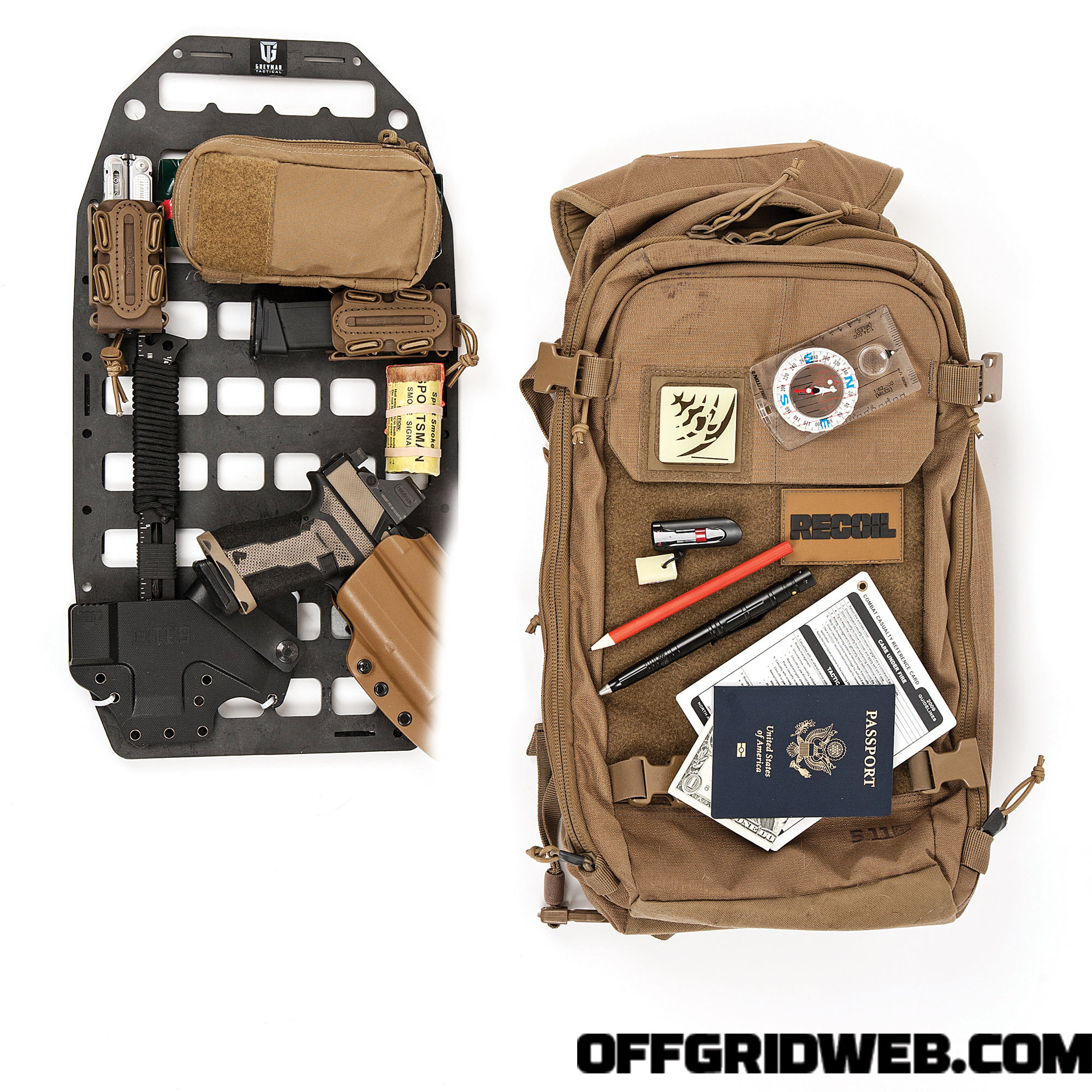
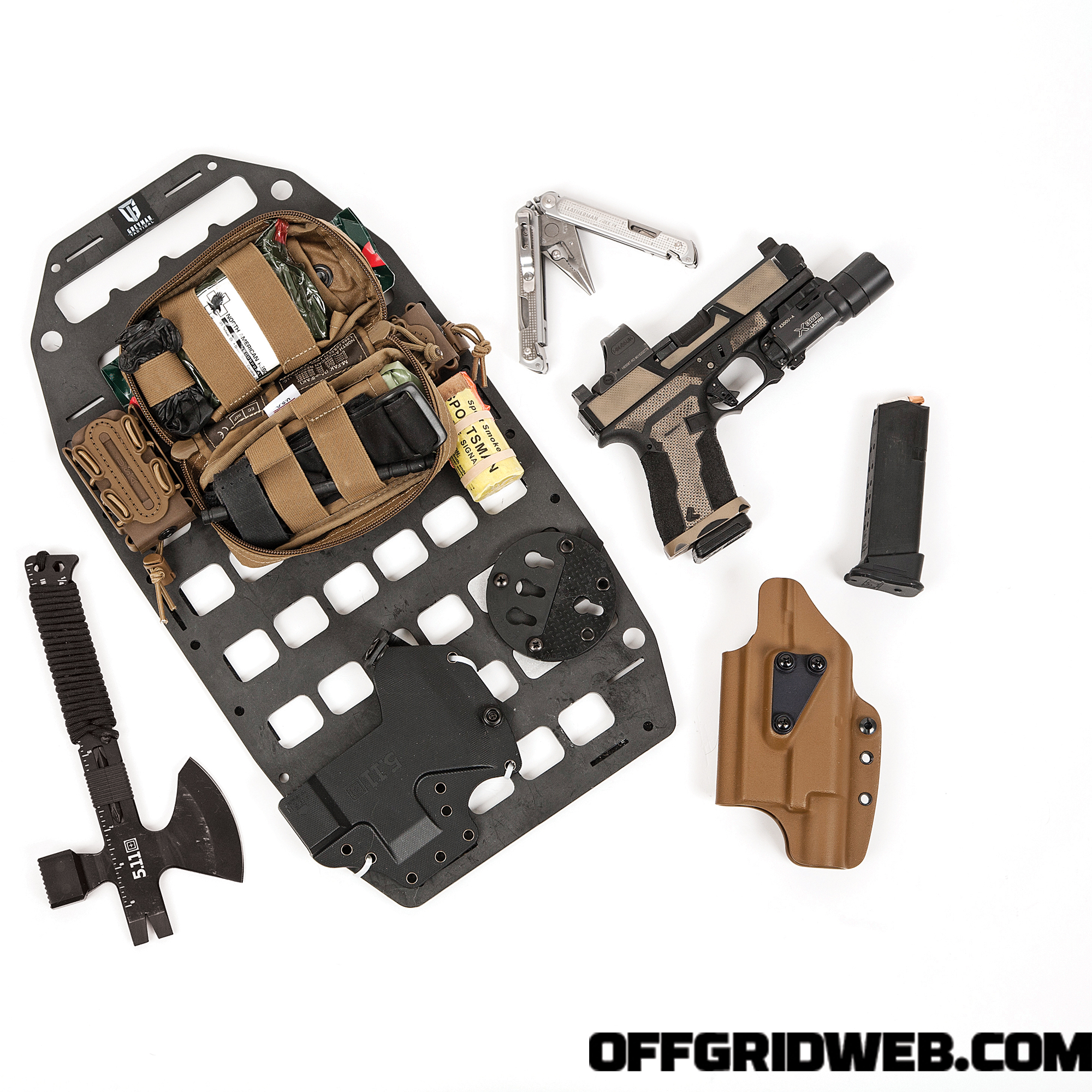
The Greyman Tactical Rigid Insert Panel has proven to be an excellent way to organize gear inside a pack. As an added bonus, if we want to use our 5.11 AMP 12 as carry-on luggage we simply remove the panel and store it while we're gone. Or pack it in our checked bag for use when we land.
>Laptop computer and charging cord
>Basic first-aid supplies (Band-Aids, Ibuprofen, antihistamines, etc.)
>Passport
>Thumb drive (with tie-on glow sprinkles cube from @whoiscitizene)
>Full-size compass
>Tactical Combat Casualty Care quick reference guide
>Tactical pen
>North American Rescue IFAK trauma kit
The NAR trauma kit provides redundancy to the LTC pocket IFAK, plus a C-A-T tourniquet.
G-Code OSH holster on RTI mounting panel
G-Code is a top-notch purveyor of Kydex and nylon tactical gear. We’ve been duly impressed with everything we’ve seen from them. But, in particular, we like the RTI mounting system in this particular setup. The RTI “wheel” is a circular mounting disc that accepts the three-pronged triangular backing plate that the company attaches to the back of its holsters. Once mounted, the wheel has a locking mechanism that keeps the holster in place. Conversely, the RTI wheel can be unlocked, and the holster can be taken out of the pack and mounted onto any other piece of kit with another mounting wheel. For my daily grind as your Editor, I typically work from home or well-known local nooks like coffee shops and cigar lounges. In these environments, I don’t typically find it necessary to have my gun on my person, but always have this bag in arm’s reach when settled in behind my laptop. For unfamiliar environments and trips to more exciting locales, I switch to my LAS Concealment Ronin 3.0 holster (see above) to keep my weapon on me as needed. https://amzn.to/2Za6n8s
Glock 19 with SureFire X300 Ultra and Holosun 508T optic
This Glock has a whole slew of performance-enhancing features, from the ported barrel/windowed slide combo by Southwest Precision Arms to the Sonoran Defense laser-stippled frame, KE Arms magwell, and Johnny Custom Glocks trigger. It’s loaded with Hornady’s 135-grain Critical Duty ammunition and equipped with a SureFire X300 Ultra weapon light for things that go sideways after sundown.
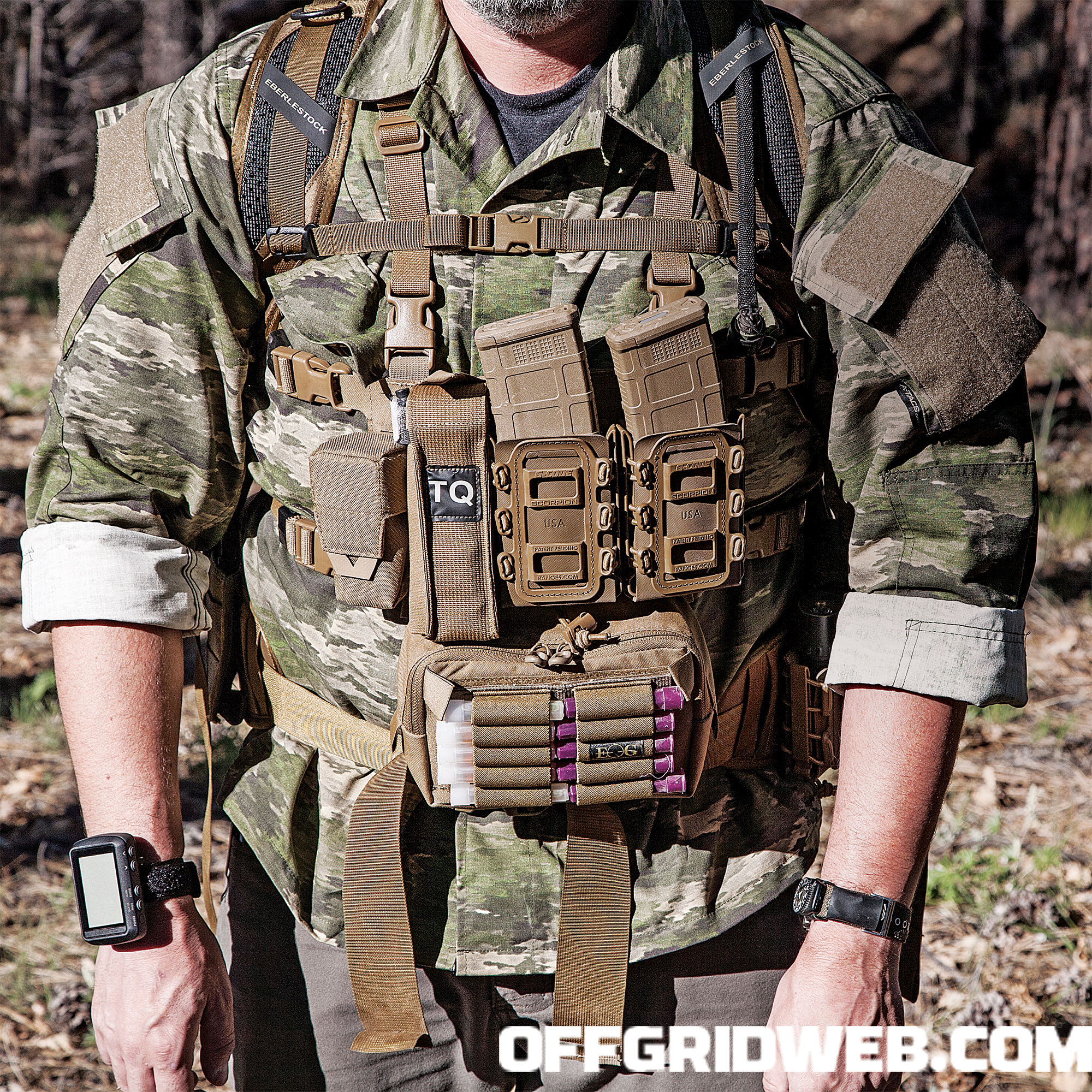
The Redwire Gear Emergency Management Rack gets donned first, with the Eberlestock pack buckled on over top of it. If the pack needs to be jettisoned, simply unbuckle the waist and sternum straps and drop it without losing your Second Line Gear.
G-Code Scorpion Softshell Mag Pouch with Spare Magazine
G-Code Scorpion Softshell Mag Pouch with Leatherman F4 Free Multi-Tool
The Leatherman Free series offers some additional capabilities above and beyond the pocket knife.
5.11 Mini Operator Ax
5.11’s Operator Ax was designed with input from former Special Forces operator and Viking Tactics owner Kyle Lamb. This is a shrunk-down version we were able to fit inside the AMP 12. The small hatchet blade and hammer on the reverse side offers limited ability for emergency breaching — whether trying to get into a wrecked car to help a trapped motorist or breaking through a door or window to escape a building fire.
Sport Smoke Sportsman Smoke Grenade
Having the ability to signal for help is vital. Patrick McCarthy discussed the importance of this capability in his visual signals Pocket Preps column in Issue 37. We like the Sport Smoke grenade by Superior Signals for its emergency-ready design. These models are wax-sealed and have an advertised shelf life of five years, so you can pack ’em and forget ’em for a while without worrying about the smoke-producing agent degrading over time. When needed, simply peel off the wax cap and pull the ring ignitor. At only $12.50 per unit, they’re a low-cost, long-lasting addition to any emergency kit.
Elastic Loop Velcro Panel with Mini Chemlights
As with smoke, keeping a couple spare chemlights in your pack is a great option to signal for help, read maps, or light your way when trying to conserve flashlight batteries — or when your batteries have already faltered.
Cobra Cuffs Flex Restraints
While we don’t plan to detain anyone with flex cuffs any time soon, these are all-around useful accessories to have that can be pressed into service for multiple other uses. Two examples: They can be used to hold double doors closed if sheltering in place from an active shooter, and they can also be used to construct splints to immobilize injured limbs.
Third Line: Use What You’ve Got!
Most city-dwellers don’t usually walk around with 72 hours’ worth of sustainment supplies on their body. Nor should they, in our opinion. Instead, make use of the best two resupply points that almost everyone has built into their daily routine: your house and your car. If you live in a major metropolitan area, suburb, or even a small town or rural farm area, your Third Line will probably be in the bed of your pickup truck, the trunk of your hybrid smart-coupe, or a bin stashed in your pantry or garage. At the end of the day, the most effective and consistently practiced preps will be those that fold into your existing routines and lifestyle. Prep around your life; don’t live around your preps.
![]()
If you don’t already do so, consider keeping a duffel bag, suitcase, or plastic tub in your vehicle with enough supplies to sustain yourself and your party for 48 to 72 hours. Are you a nuclear family with three kids? That’s three days’ worth for everyone. Are you and your partner young professionals just starting out? Six days’ worth total, then. What does three days of sustainment look like? In the end, you’ll have to figure that out for yourself. We suggest keeping it sparse; don’t pack an entire second home. Even if you normally eat three full meals and a couple snacks every day, you can easily last on half that (if not less) for a short duration. Either way, the essentials probably include:
>Food
>Water
>Basic hygiene/sanitation (wet wipes, hand sanitizer, dry shampoo, some toilet paper or paper towels)
>Weather protection (sunscreen for desert dwellers, extra pairs of thermal underwear and hand warmers for northlanders)
>Emergency signaling (flares, strobe lights, smoke signals, whistles, etc.)
>One full pair of clean clothes (shirt, pants, socks, underwear, jacket/fleece)
>Chargers or battery packs for all electronic communications
If possible, include a store of emergency cash. This could be used for everything from paying for a tow truck or buying a couple gallons of gas, to tipping a stranger to hitch a ride or borrow their cell phone, to using it as “throwaway” money if confronted by opportunistic criminals.
For this particular scenario, we won’t dive into a specific sample loadout for Line Three. Instead, we’ll move into another example of how to array your “Line Gear” where a Third Line becomes much more succinct.
While your Editor spends his day-to-day lounging around caffeine and tobacco wells, tapping away at a keyboard and scrolling through social media, short and sometimes spontaneous excursions into the surrounding mountainous desert are a welcome reprieve that can typically be planned and executed in about 30 minutes. Hitting the trail poses a new set of challenges and restrictions that require some retooling of the gear lines outlined above.
Line One, at least for us, doesn’t change much. As the term EDC would imply, we carry those items and tools on us or with us, regardless of the ebb and flow of daily routine. So, for the sake of simplicity, we’ll skip listing out a separate First Line and instead focus on what changes when you go from blacktop to backwoods.
Second Line: Redwire Gear Emergency Management Rack and Demo Pouch
The open carry of weapons and gear is more convenient and commonly accepted when traversing the great wide-open, whether for an afternoon or weekend. Initially developed by commandos in Asia and Africa for carrying spare ammo, the chest rig has evolved into a modular, utilitarian platform to carry all manner of survival sundries. We especially like chest rigs for hikes, as they can be worn in conjunction with a backpack and give us quick access to supplies without having to stop and drop ruck to reach them. The Redwire EMR is one of the slimmest, lightest chest rigs we’ve put hands on to date, carrying a Goldilocks “just right” amount of gear while keeping weight and bulk to minimum. We’ve set ours up with the following:
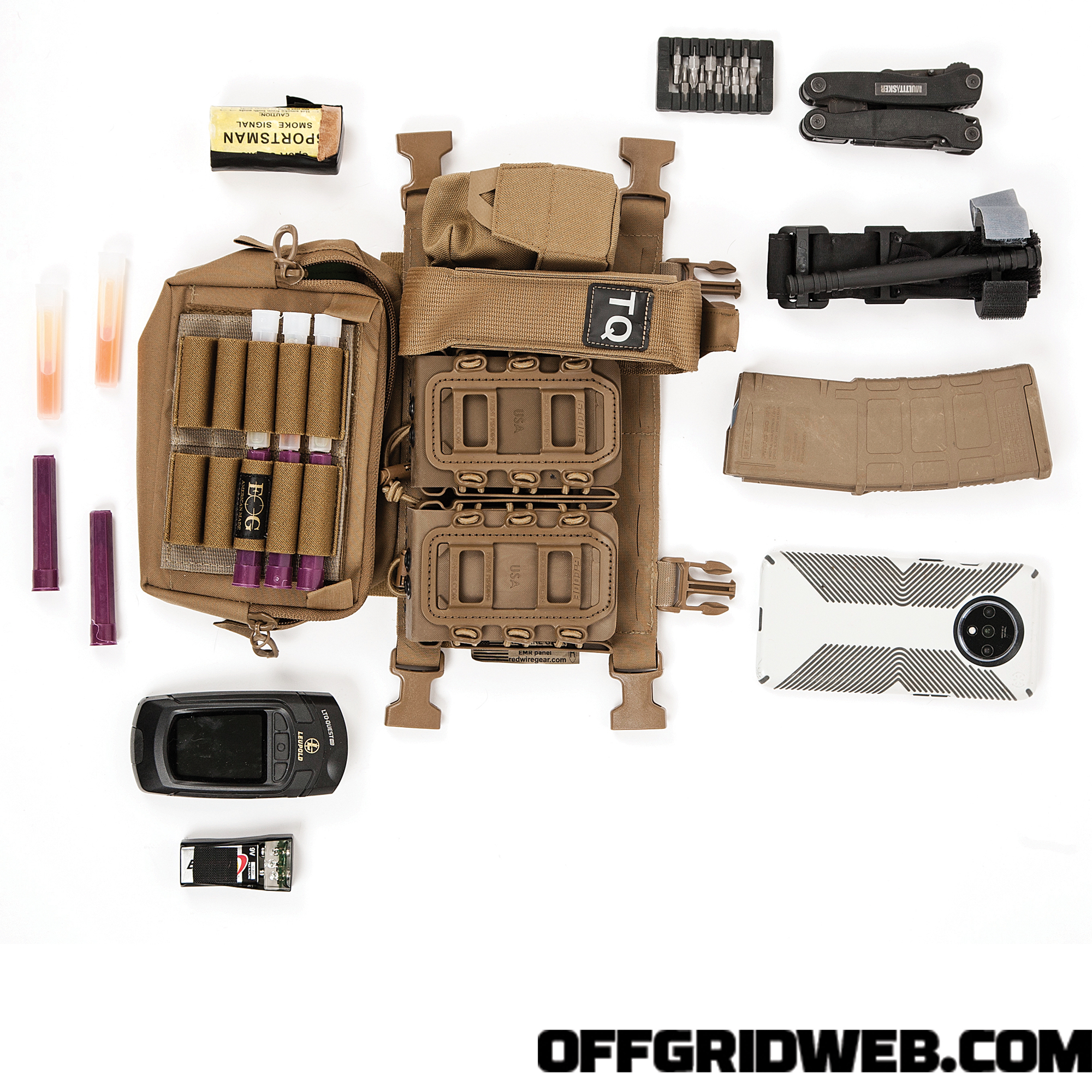
Shoot, Move, Communicate, Medicate — those are the “Big 4” tasks you may be required to do in an emergency situation. The Redwire Gear chest rig allows you to carry enough gear to do all four in a footprint about the size of most T-shirt logos.
2x G-Code Scorpion Softshell Rifle Mag Carriers
The stretchy bungee retention and hybrid cloth/polymer construction of the Scorpion Softshell carriers allows them to be used for a variety of purposes. We have two on our chest rig — one for a spare 30-round carbine mag and one for our cell phone. (Since our Third Line pack has a waist belt, it can be tough digging into your pants pockets on the go.)
Blue Force Gear Tourniquet NOW Pouch
Tourniquets are one of those items that you’ll probably never have to use but, if you do, you want it 10 minutes ago. Our First Line med kit doesn’t include a hard tourniquet, so we mounted one on our Second Line. The Blue Force pouch holds one C-A-T or similar TQ in an easy-to-access, rip-open vertical caddy. Putting it almost dead center on the rack allows it to be accessed with either hand from almost any angle with minimal movement.
Emdom USA Multitasker Pouch
Just as with our urban-focused Second Line, we wanted to include a multi-tool of some kind. We used a Multitasker for several years and carried it all kinds of places, including overseas and around the country. It includes a bit set and several AR-specific features, like a front sight adjustment tool and a castle nut wrench. The Emdom pouch accommodates the tool itself and has a separate pocket for the bit set that comes with it.
Redwire Demo Pouch
Redwire Gear also makes the hanger/dangler/abdominal/subload pouch (whichever term you care to use). There are a number of these types of pouches on the market, and in the tactical duty world, they’ve become a popular addition to all manner of chest rigs and plate carriers to carry additional gear. We like the Demo Pouch in particular because the inside is lined with tennis-ball-green Velcro — soft side on the back wall of the pouch, hook side on the front wall. With a couple of strips of adhesive Velcro from the hardware store, you can make sure the items in your demo pouch are securely fastened and won’t rattle around in there. We stowed the following items in ours:
>Sportsmoke Sportsman’s Smoke Grenade
>Leupold Handheld Thermal Optic
>Firefly Infrared Beacon
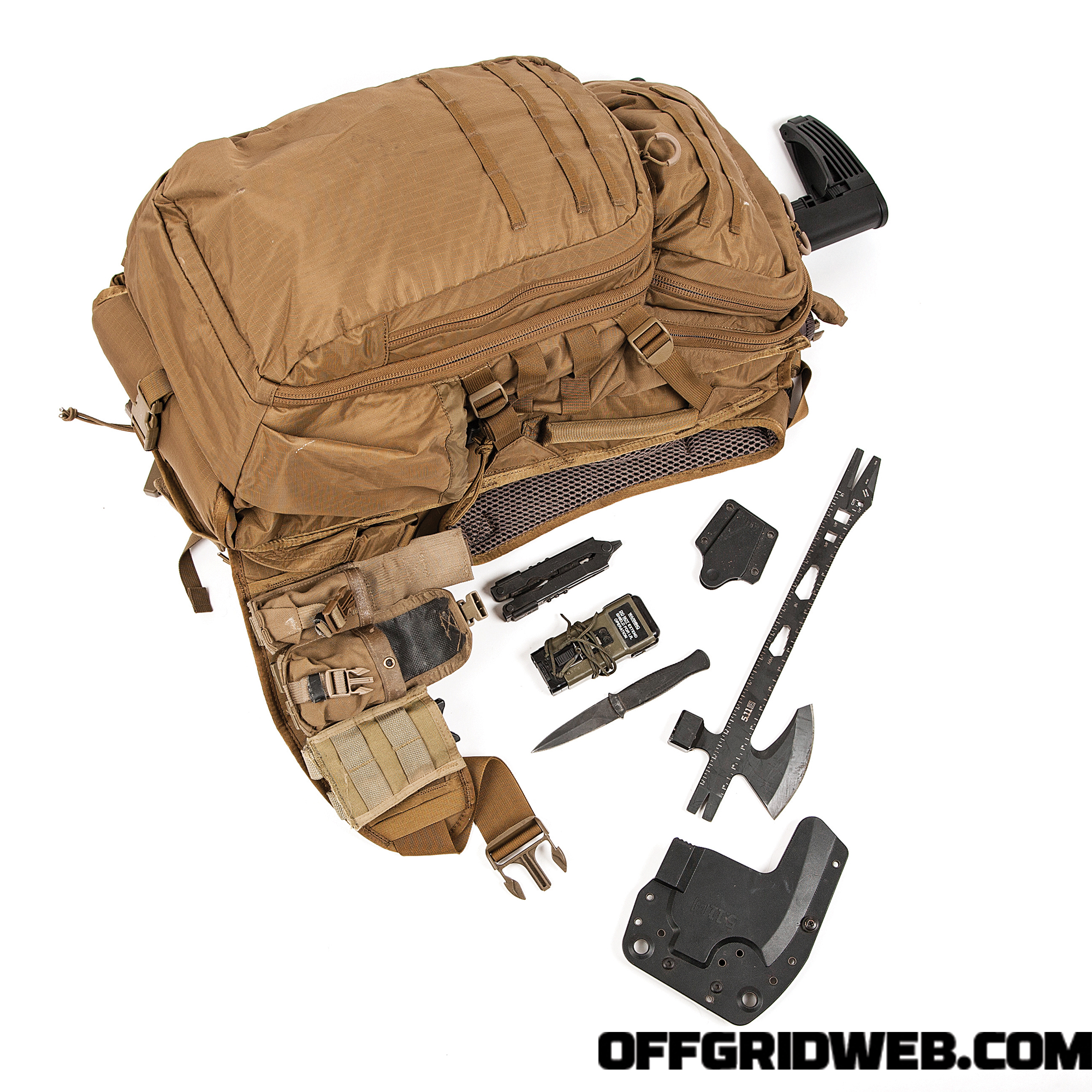
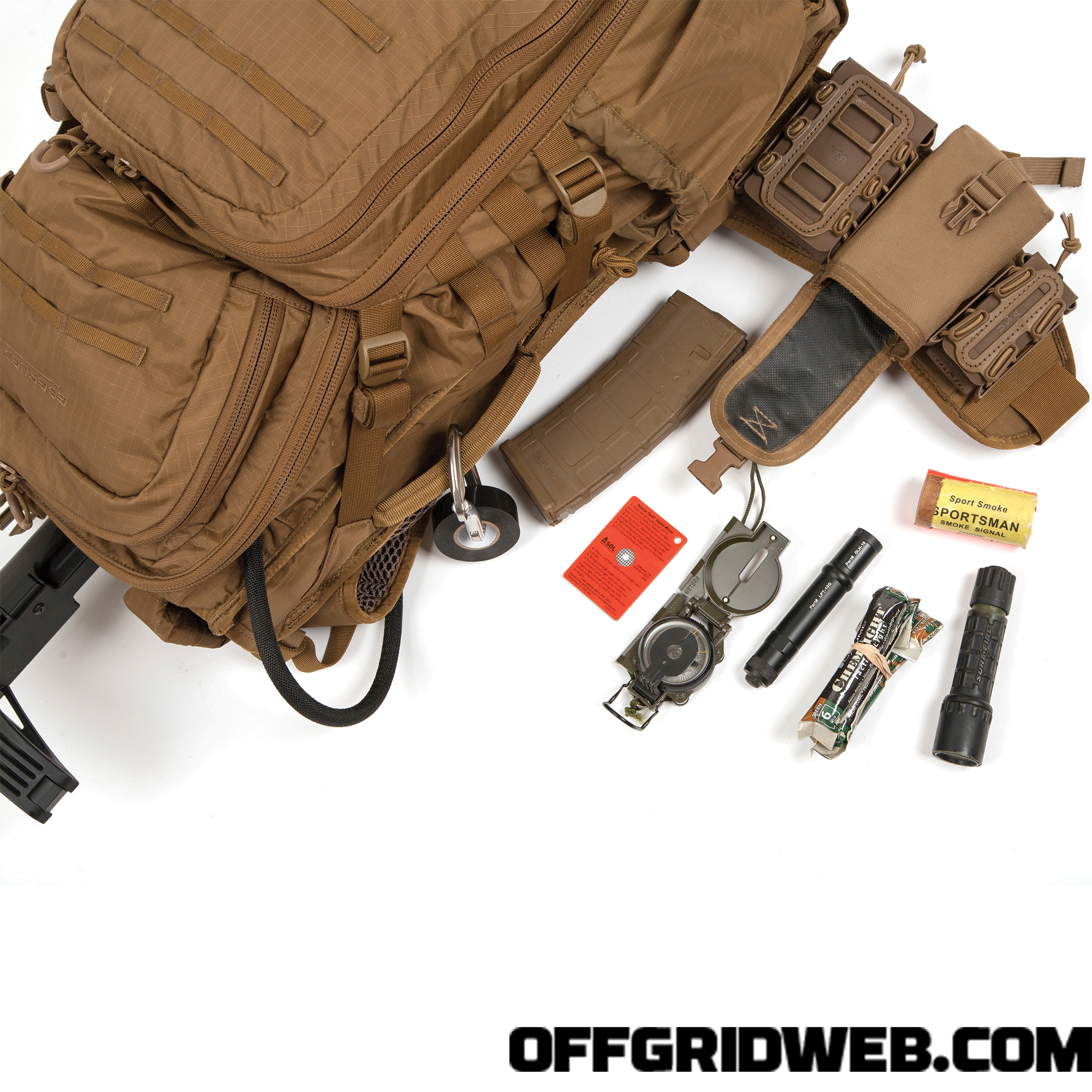
Our outdoors pack also contains the full-size version of the 5.11 Operator Axe. It's got a longer handle that features a pry bar at each end as well as a larger blade and hammer head.
The search-and-rescue groups in our area regularly coordinate with both federal and local law enforcement air assets to find missing or distressed hikers, and both the federal and local agencies operating in our area have FLIR-equipped aircraft. Therefore, an IR beacon is a legitimate, excellent way to signal potential rescuers without drawing unwanted attention from animals or criminal elements. We like the Firefly because it’s so small and simple to operate. Just snap the beacon directly onto the leads of a household 9-volt battery and wait for the cavalry. To store it, flip the beacon upside down and tape it to the battery. They’re small enough that you can carry several to mark a large campsite or landing zone, or drop them along a trail like IR breadcrumbs if you have to move. They can also be attached to packs, helmets, and hats, or left in trees. According to the manufacturer, the signal is so bright that the Firefly can be placed in your pocket and still be detected by IR goggles and cameras.
Explosive Ops Gear MOD 1 Chem Light Panel
One of the other things we like about the Redwire Demo pouch is that the front of it has a huge field of Velcro to accept patches or panels. We chose the MOD 1 Chem Light Panel from Explosive Ops Gear. EOG is a tiny gear company based on the East Coast and, like Redwire, composed of current and former Explosive Ordnance Disposal specialists. The MOD 1 is designed to hold up to five full-size chemlights or 10 miniature ones. We set it up with the latter, allowing us to have both visible and IR lights on hand, depending on the situation and how “loud” we want our distress signal to be.
Third Line: Eberlestock Lo Drag II
With the infinite number of day packs and hiking packs on the market today, there’s bound to be one out there that fits your wants and needs exactly, or comes pretty damn close. We settled on the Lo Drag II by Eberlestock. We knew the application would be for a short-range pack meant for day hikes and trail use. We also knew we wanted something that wasn’t excessively large — a bag that allows you to over pack can be just as bad as one that’s too small to hold what you need. We packed ours with the following:
On waistbelt:
>Gerber fixed blade knife
>Military-style white light/IR dual-use beacon
>Leatherman multi-tool
>30-round carbine magazine
>Military-style lensatic compass
>Fire-starting kit including Fiber Light tinder and ferro rod
>SureFire G2 Nitrolon flashlight with Malkoff Devices drop-in conversion head (The Malkoff lamp assembly uses a fully potted LED bulb and improved reflector. While the original G2 Nitrolon had a meager 60-lumen output, the Malkoff add-on bumps that to 250 lumens.)
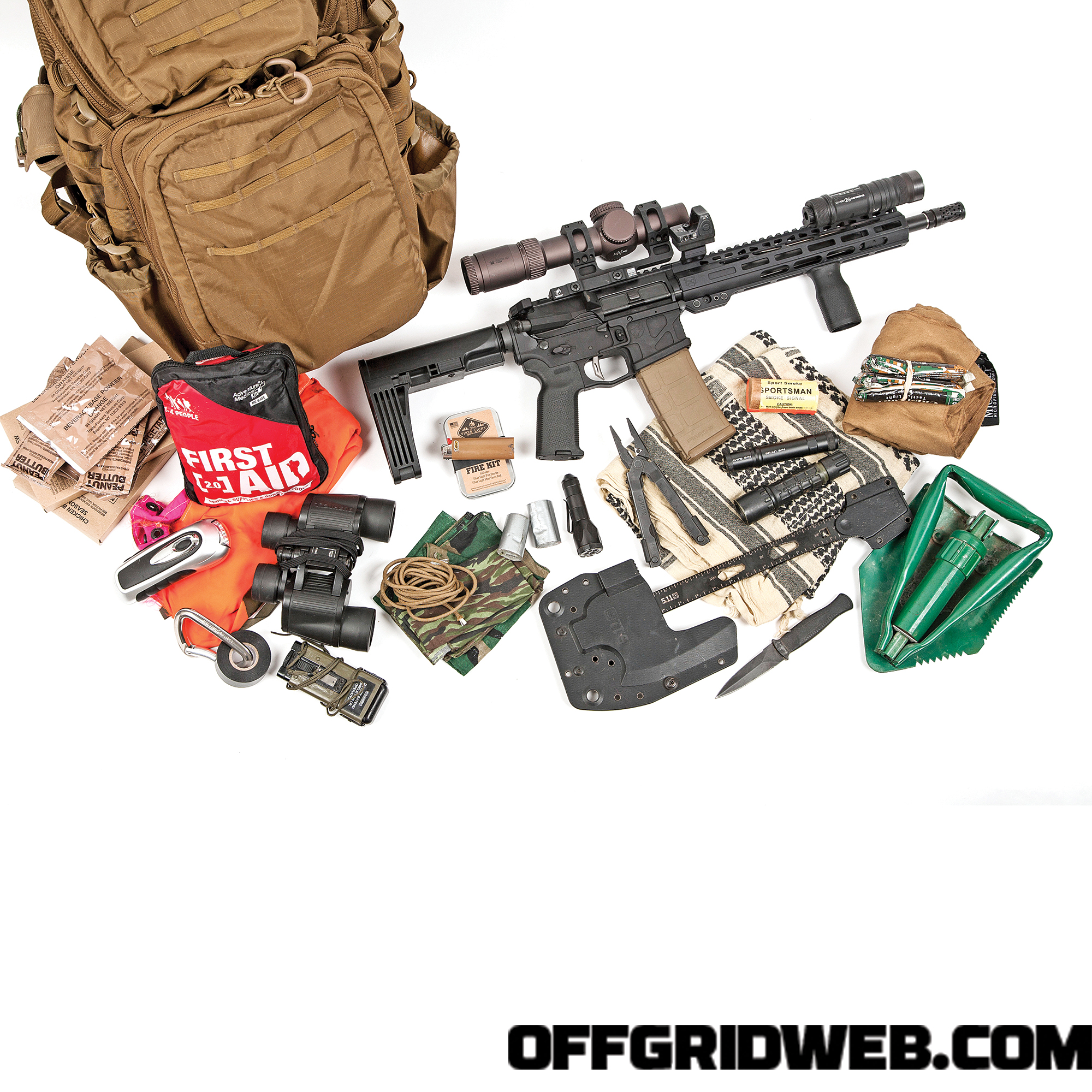
Building in redundancy is always a good idea. For example: smoke signals, chemlights, and ammo are included in both our Second and Third lines. Even if you're required to ditch an entire line, you retain certain critical capabilities no matter what.
Inside the pack:
>3 stripped-down/disassembled MREs
This leads us to our only gripe about the Eberlestock Lo Drag. Its main compartment features two full-sized laptop sleeves that are sewn into the bag and can’t be removed. For a bag that otherwise seems geared toward outdoor and field use, this seems like an odd feature. However, we cut open a couple of MREs and used the laptop sleeves like an accordion file to sort the various main dishes, sides, snacks, and ancillary components of the MREs.
>300-ounce water bladder
>Shemagh/head scarf
>Microfiber camping towel
>General first-aid kit
>Collapsible entrenching tool/shovel
>Military “VS-17” signal panel
>Emergency space blanket
>550 cord
>Butane lighter
>Carbine
This is our favorite part of the Lo Drag II — it comes with a built-in sleeve for a carbine. The sleeve can be unrolled to its full length, causing it to hang down below the rest of the pack, to hold a carbine up to 36 inches in overall length. Or you can keep the bottom portion rolled up tight and still fit a 24-inch gun. We chose the latter option and are running a 12.5-inch Sage Dynamics “K9” upper from Rosco Manufacturing. It’s set up with a Vortex Razor 1-10x optic and Trijicon RMR red dot in an Arisaka Defense offset mount. The 12.5-inch barrel is match grade, made of 416R stainless, and finished in black nitride. The Rosco upper is mated to an American Defense Manufacturing lower with fully ambi controls and a Gear Head Works pistol brace. This setup allows us to carry a sub-30-inch gun that’s capable of hitting targets out to 500 meters with the right ammunition. It fits into the Lo Drag’s weapon sleeve with only the brace and the end of the lower sticking out.
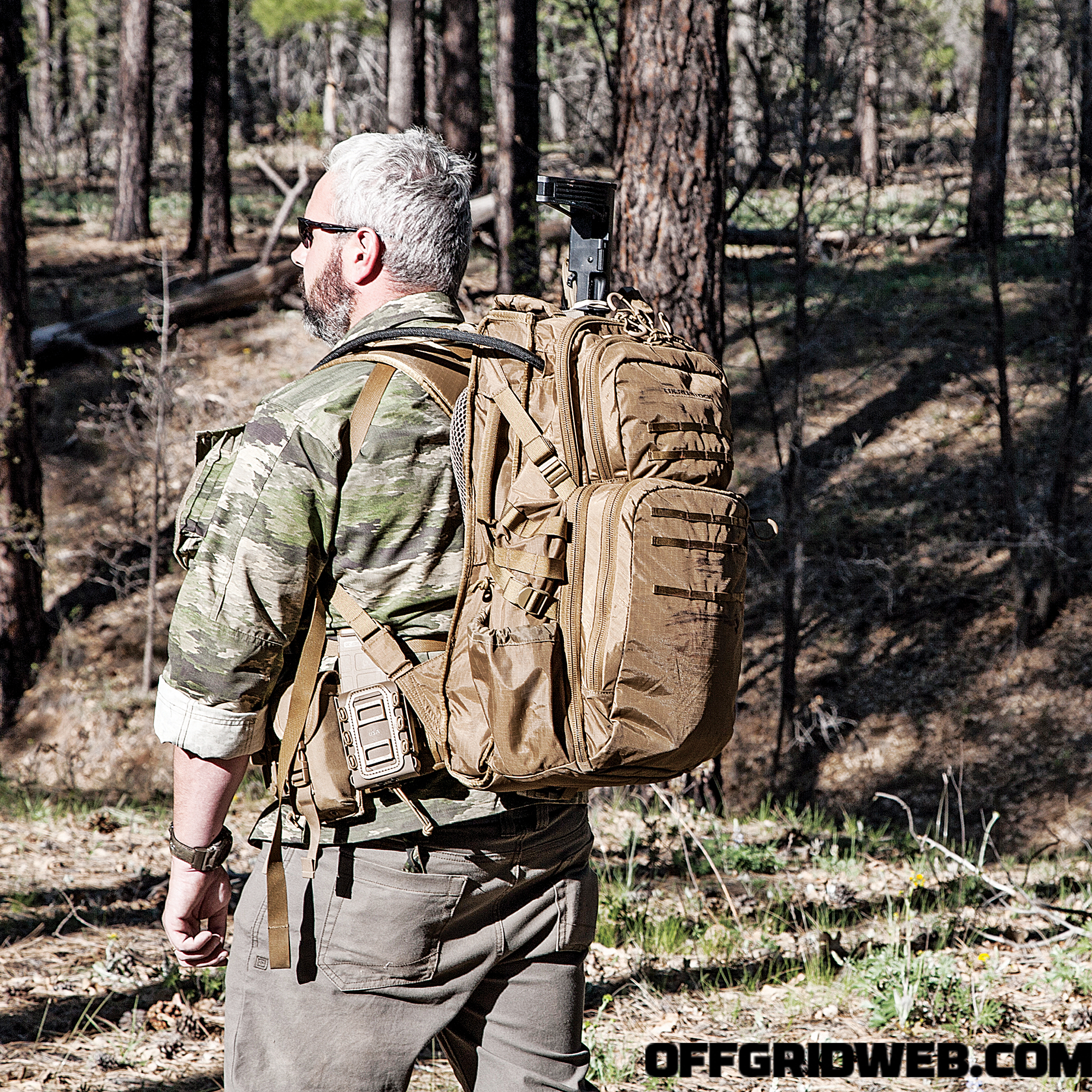
The Eberlestock Lo Drag II is a medium-sized pack that works well for all-day outings with enough room for the supplies you'll need if your day hike turns into an unscheduled overnight.
THE LAST LINE
Our hiking setup falls a little more in line with the original Special Forces paradigm of Line Survival Gear. If we were on the run through the mountains from some hypothetical pursuing enemy and needed to drop the Eberlestock pack, we could remove the rifle, take the 30-round mag off the waist belt and load it into the “cell phone pouch” on our Redwire EMR, and get moving again with 90 rounds of 5.56mm, as well as some signaling and medical capability. If, for some reason, I had to shed the carbine and chest rig, I would still have a knife, light, fire-starting ability, mini IFAK, and some E&E tools.
Is this a likely scenario for any of us to encounter? No, but it illustrates the practical lessons of the Line Survival Gear philosophy. Note how it incorporates the guiding principles of redundancy and prioritization. Once you understand the purpose of each “line” in your total preparedness strategy, you can scale the system in any way necessary to meet your needs. So, if you have mountains of gear stored in the shed or stuffed into old laundry bags, maybe it’s time to get your gear in line.
 STAY SAFE: Download a Free copy of the OFFGRID Outbreak Issue
STAY SAFE: Download a Free copy of the OFFGRID Outbreak Issue
No Comments